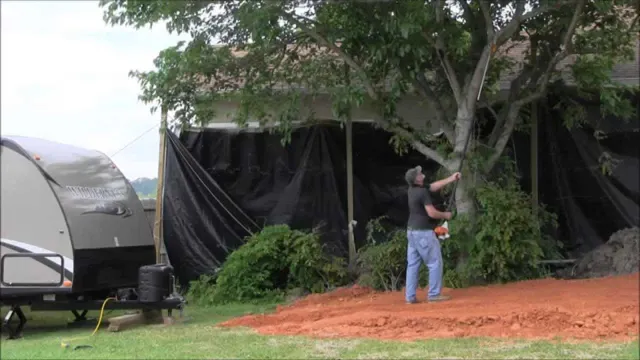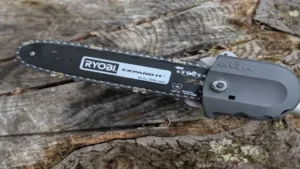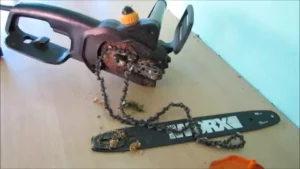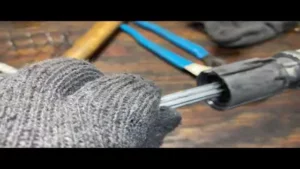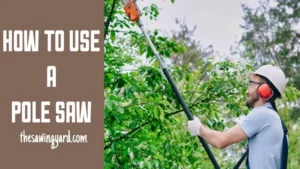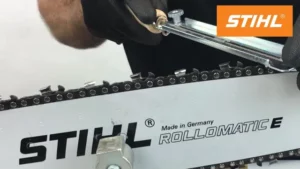Trimming trees can be a daunting task, especially when you don’t have the right tools. But fear not! With a pole saw in hand, you can easily tackle your tree trimming project without having to call in the professionals. A pole saw is a type of pruning saw that has a long, extendable handle, allowing you to reach high branches without having to use a ladder.
It’s a fantastic tool for keeping your trees in top shape and removing any branches that might be posing a danger. So, how exactly do you use a pole saw to trim a tree? In this blog post, we’ll provide you with step-by-step instructions to get you started. From selecting the right pole saw for your needs to identifying the branches that need to be trimmed, we’ll cover everything you need to know to get the job done safely and efficiently.
By the end of this post, you’ll have the knowledge and skills you need to confidently trim your tree with a pole saw. So grab your tool and let’s get started!
Step 1: Assess the Tree
If you plan on trimming a tree with a pole saw, the first step is to assess the tree. Before starting any trimming work, it’s important to determine if the tree needs pruning at all. Inspect the tree for any dead, diseased or damaged branches, any branches growing very close to each other, or any branches that may have become too heavy and may pose a risk of falling.
Also, assess the overall shape of the tree, whether it has grown too tall or too wide, and if it’s blocking any sunlight. In general, the best time to trim a tree is during the dormant season, which is usually in late winter or early spring. By assessing the tree first, you can determine what areas need pruning, prevent damage or harm to the tree, and ensure that the job is done safely and efficiently using your pole saw.
Consider the size, height, and type of tree
Assessing a tree is the first step in deciding if it needs to be removed from your property. The size, height, and type of tree are all important factors to consider during this assessment. Large trees with extensive branching and trunk diameters require greater care in the removal process, while taller trees pose greater risks of damage to surrounding structures during removal.
The type of tree is also significant, as some species have more shallow roots and may be more susceptible to falling in high winds or heavy rain. By considering all of these factors, you can determine the best course of action for any tree that may need to be removed from your property. Ultimately, the goal is to ensure the safety of your property and those around you, while also maintaining the aesthetic value of your landscape.
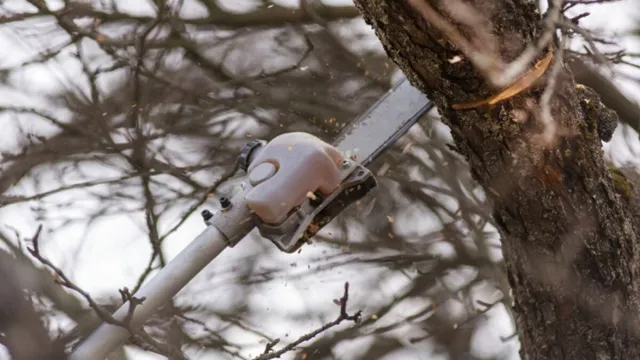
Step 2: Choose the Right Pole Saw
When it comes to trimming trees with a pole saw, it’s essential to choose the right tool for the job. There are various types of pole saws available, including electric, gas, cordless, and manual saws. Electric pole saws are ideal for smaller trees and branches, while gas pole saws are more powerful and suitable for larger trees.
Cordless pole saws offer the convenience of not being tethered by a cord, while manual saws are perfect for smaller pruning jobs and are the most affordable option. It’s crucial to consider the height and thickness of the tree’s branches before choosing a pole saw. The length of the pole saw and its weight are also important factors to consider for your comfort and ease of use.
Remember, you want a pole saw that is not too heavy, as it can be cumbersome to maneuver, but not too light to compromise its effectiveness. By choosing the right pole saw, you can trim your tree with ease and precision, putting your mind at ease knowing your tree will remain healthy and well-kept.
Select a saw with a long pole, sturdy blade, and adjustable angle
When it comes to selecting the right pole saw, there are a few key factors to consider. Firstly, you want to choose a saw with a long pole to ensure that you can reach higher branches without having to climb a ladder or put yourself in danger. Additionally, you want to make sure that the blade is sturdy and can handle tough branches without bending or breaking.
Lastly, an adjustable angle is crucial, as it allows you to easily switch between cutting different branches at different heights and angles. With these features in mind, you’ll be able to choose a pole saw that makes pruning trees and trimming branches a breeze. Keep in mind that when looking for a pole saw, it’s important to choose one that is reliable and built to last, as a high-quality tool will save you time and money in the long run.
So, take your time, do your research, and invest in the right pole saw for your needs.
Step 3: Prepare the Area
Once you’ve chosen the right pole saw and decided on the branches you want to trim, it’s important to prepare the area. First, make sure there are no people or animals around who may get hurt by falling branches. Then, clear away any obstacles that may get in the way, such as garden furniture or rocks.
It’s also a good idea to wear protective gear such as gloves, eye goggles, and a hard hat to protect yourself from any falling debris. Once you’ve done this, you’re ready to start trimming your tree with your pole saw. Remember to take it slow and steady, and make sure you have a good grip on the saw at all times.
With a little bit of practice, trimming your tree with a pole saw can be a safe and easy task to accomplish.
Clear the ground of obstacles and ensure a safe work area
Preparing the work area is crucial to ensuring a safe and successful project. One of the first steps to take is to clear the ground of any obstacles, including debris, tools, and equipment. Any obstacles can be a hazard to both you and others working in the area.
You want to create ample space to move around and work freely. Another essential step is to create a safe work area. This can be achieved by setting up barricades or safety cones to keep people out of the space.
Additionally, be sure to check for other potential hazards, such as electrical cords, uneven surfaces, or slippery areas. A clear and safe work area is essential to reduce the risk of accidents and mishaps, and it sets the stage for a successful project. Taking the time to prepare the area before starting the project will save time and prevent problems later on.
By following these steps, you can create a safe and efficient work area that will help you achieve optimal results.
Step 4: Trim the Branches
When it comes to trimming a tree with a pole saw, it’s important to know how to properly trim the branches. Begin by identifying any dead, diseased, or damaged branches and removing them first. Next, check for any branches that are crossing or rubbing against each other, as these can cause damage or hinder the tree’s growth.
Using the pole saw, make clean cuts on the branch just outside the branch collar, which is the raised area where the branch connects to the trunk or another branch. It’s important to avoid leaving stubs or cutting too close to the trunk, as this can cause damage and even disease. Be sure to also avoid trimming more than 25% of the tree’s crown, as this can harm the tree and its overall health.
By properly trimming the branches with a pole saw, you can help promote healthy growth and maintain the beauty and safety of your trees.
Start with the lower branches and work your way up
When it comes to trimming the branches of a tree, it’s important to start with the lower branches and work your way up. This is because the lower branches are usually the larger and thicker ones, which can be harder to manage if you cut the higher branches first. By starting with the lower branches, you can also get a better idea of the tree’s shape and structure, which can guide you when deciding which higher branches to cut.
Additionally, cutting the lower branches first can make it easier to move around the tree and access the higher branches. So, grab your pruning shears and start at the bottom, working your way up to achieve the perfect shape and size for your tree. Remember, always prioritize safety and don’t hesitate to call a professional tree service if you feel uncomfortable or unsure about trimming your tree on your own.
Step 5: Clean Up the Debris
Congratulations on successfully trimming your tree with a pole saw! But before you pat yourself on the back, there’s still one more step to go: cleaning up the debris. This step is crucial to the health of your tree and keeping your yard looking tidy. Start by removing any branches or twigs that fell on the ground, making sure to dispose of them properly.
Avoid leaving them on the ground as they can attract pests and disease. Once the ground is clear, it’s time to inspect your tree for any areas that may need more attention. Look out for any jagged or torn limbs that may attract insects or disease.
Use the pole saw to gently smooth out the edges to prevent further damage. Remember, the goal is to improve the health of your tree, so take your time and be thorough. With a little bit of patience and attention to detail, your tree will thank you for it.
Remove all cut branches and dispose of them properly
Removing all cut branches and disposing of them properly is an essential step in cleaning up debris after pruning trees. When trimming trees, it’s common to have a lot of branches and leaves scattered all over the ground. Leaving the debris can be hazardous and unsightly, which can attract pests and insects that could cause damage to your lawn or garden.
To avoid this, collect all the cut branches and debris and dispose of them properly. You can collect the debris with a rake and dispose of them in a trash bag or burn them if it’s legal to do so in your area. You can also take the branches to a local composting facility where they can be recycled and turned into mulch.
It’s crucial to remove all the debris to keep the environment clean and reduce the risk of accidents. By taking the time to clean up after pruning, you’ll have a healthier and more aesthetic garden that you’ll be proud to show off to your friends and family.
Safety Precautions
If you’re wondering how to trim a tree with a pole saw, there are a few essential safety precautions to keep in mind. First and foremost, make sure you choose a sturdy, well-built pole saw that is designed for the job. You should also wear the appropriate protective gear, including eye and ear protection and sturdy work gloves.
When trimming a tree, always work with a partner who can help you stabilize the saw and offer assistance if needed. Additionally, be mindful of your surroundings and avoid trimming near power lines or other hazardous areas. Finally, take your time and work carefully, making sure to follow all manufacturer’s instructions and safety guidelines for your specific pole saw model.
With these precautions in mind, you can safely and effectively keep your trees healthy and vibrant.
Wear protective gear, use caution, and work with a partner if possible
When it comes to any kind of physical work or activity, safety must always come first. This is especially true for those who work in construction, DIY projects, or outdoor recreation activities. Wearing protective gear such as goggles, helmets, and gloves can make a big difference in preventing injuries.
Additionally, it is important to use caution and work with a partner whenever possible. Two pairs of eyes and hands are always better than one, and having someone there to assist you can greatly reduce the risk of accidents. Remember, safety should always be a top priority when engaging in any kind of physical activity.
So, the next time you embark on a project or adventure, ask yourself, am I taking the necessary safety precautions? By doing so, you can help ensure a successful and injury-free outcome.
Conclusion
In summary, trimming a tree with a pole saw is like giving your tree a stylish haircut – it not only improves its appearance but also promotes its health. However, like any haircut, it requires patience, attention to detail, and the right tools. By selecting the appropriate pole saw, taking safety precautions, and following proper techniques, you can achieve a well-groomed tree that will make all your neighbors envious.
So go ahead, channel your inner arborist, and get pruning – your tree will thank you for it!”
FAQs
What is a pole saw and how does it work for trimming trees?
A pole saw is a specialized tool designed for trimming tall trees and branches. It consists of a long pole with a saw blade attached at the end. To use it, you extend the pole to reach the branch or tree and use a pulling motion to cut through the wood.
How do you choose the right pole saw for tree trimming?
When selecting a pole saw, you need to consider the height of the trees you will be trimming, the thickness of the branches, and the type of saw blade. Look for a pole saw with a long enough reach to safely access and cut through the branches without straining yourself.
Can you use a pole saw for pruning smaller trees and shrubs?
Yes, a pole saw is a versatile tool that can be used for pruning smaller trees and shrubs as well as larger ones. You can adjust the length of the pole to reach the desired height and use the same pulling motion to cut through the branches.
What safety precautions should you take when using a pole saw for tree trimming?
When using a pole saw, always wear personal protective equipment such as eye and ear protection. Ensure that the area beneath the tree is clear of people, pets, and objects that could be hit by falling branches. Also, make sure the pole saw is properly assembled and maintained for safe and efficient use.
How do you maintain and sharpen the blade of a pole saw for tree trimming?
To maintain and sharpen the blade of a pole saw, clean it regularly with a wire brush or abrasive pad to remove any debris or sap. Use a sharpening file or stone to sharpen the teeth of the blade, filing in the direction of the teeth. Always wear gloves and follow the manufacturer’s instructions when working with the blade.
What is the best time of year to trim trees with a pole saw?
The best time of year to trim trees with a pole saw is during the dormant season, which is typically in late fall or winter. This is when the tree is not actively growing, and pruning will cause the least harm to the tree. Avoid pruning during the spring or summer when the tree is actively growing to prevent damage and stress.
How do you properly dispose of tree trimmings after using a pole saw?
Properly disposing of tree trimmings after using a pole saw involves several steps. First, remove any large branches and limbs and cut them into smaller pieces for easier disposal. Then, gather the smaller branches, leaves, and debris and place them in a compost pile or green waste bin if available. Finally, dispose of any remaining waste according to local regulations.
